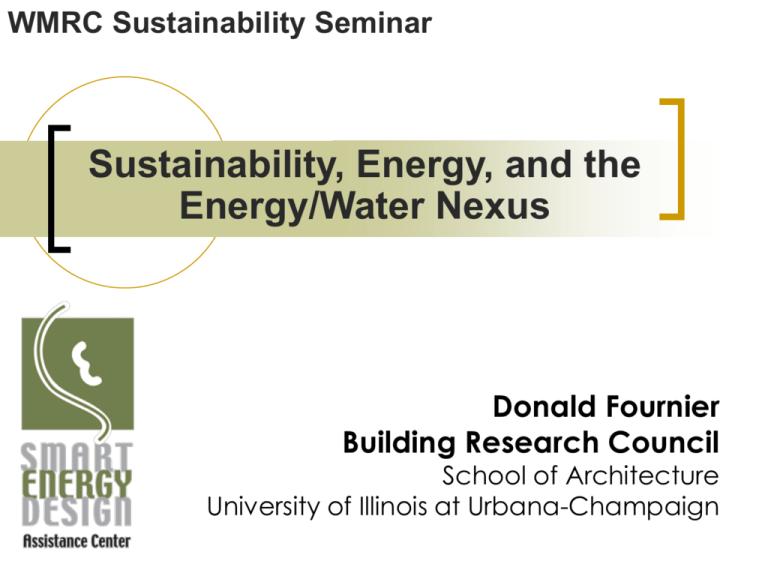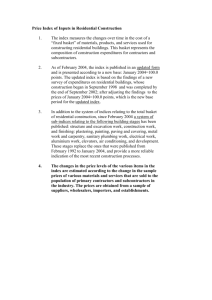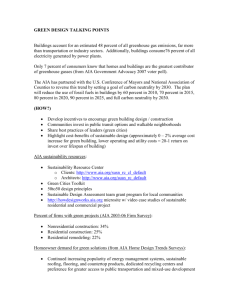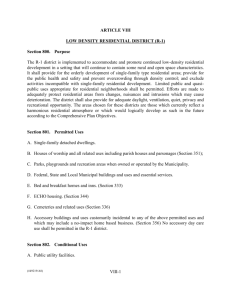PowerPoint - Illinois Sustainable Technology Center
advertisement

WMRC Sustainability Seminar Sustainability, Energy, and the Energy/Water Nexus Donald Fournier Building Research Council School of Architecture University of Illinois at Urbana-Champaign Overview Background (US and World Energy situation). Sustainability and the tech fix. Can we get there? The Energy Water/ Nexus. Source: DOE/EIA International Energy Outlook 2007 World Energy Use (Quads) Source: DOE/EIA Annual Energy Outlook 2007 US Energy Use (Quads) Source: DOE/EIA Annual Energy Outlook 2006 US Electric Generation by Fuel Billion kWh 2006 – 4,065 B kWh Should be 3927 B kWh (2 years ahead) Source: ASPO Sep 2006 Actual Production 2003 – 79.62 Mbd 2004 – 83.12 Mbd 2005 – 84.63 Mbd 2006 – 84.60 Mbd 2007 – 84.34 Mbd DOE/EIA, November 2007 Petroleum Prices Natural Gas Prices Source: DOE/EIA 2007 (thru August) Natural Gas Prices Source: DOE/EIA 2007 Coal Prices U.S. Energy Flows 2006 69% 22% Source: DOE/EIA 2007 Renewable Energy US Energy Production Last year: PV grew 33% Wind grew 27% Biofuels grew >23% Coal grew 2.5% Natural Gas grew 2.3% Oil grew 1.0% Nuclear Electric grew 1.0% Atmospheric CO2 Carbon Emissions “Unknowingly, the architecture and building community is responsible for almost half of all U.S. greenhouse gas emissions annually. Globally the percentage is even greater.” US Energy Information Administration statistics Graphic Published first in Metropolis Magazine, October 2003 Issue Energy Trends in Buildings Average energy consumption (Btu/sq. ft) Before 1920 80,127 1920 – 1945 90,234 1946 – 1959 80,198 1960 – 1969 90,976 1970 – 1979 94,968 1980 – 1989 100,077 1990 – 1999 88,834 2000 – 2003 79,703 Source: EIA/DOE 2006 Energy Book They predict no improvement in efficiency for the next 30 years for new or existing! What are they smoking???? Or ???? Opportunity for Change Each year in the United States, we tear down approximately 1.75 billion square feet of buildings, renovate 5 billion square feet, and build new another 5 billion square feet. During the next 30 years, some 50 billion square feet will be torn down, some 150 billion will be renovated, and another 150 billion will be built new. By 2030, three-quarters of the built environment will be either new or renovated. AIA COTE: Ecology and Design: Ecological Literacy in Architecture Education, 2006 AIA 2030 Position Statement Promote sustainable design including resource conservation to achieve a minimum 50 percent reduction from the current level of consumption of fossil fuels used to construct and operate new and renovated buildings by the year 2010, and promote further reductions of remaining fossil fuel consumption by 10 percent or more in each of the following five years. Source: AIA November 2005 AIA 2010 Goals AIA baseline is ENERGY STAR® Target Finder. This is the average building of that type in that weather region. Average Office building in Chicago uses: 92.3 kBtu/sf (5,000 sf) 101.5 kBtu/sf (20,000 sf) 113.3 kBtu/sf (100,000 sf) Pretty weak standard! ASHRAE Std 90.1-1999 yields about 67 kBtu/sf for an office building (including plug loads). If we target 30% below that (about 47 kBtu/sf), you will get an AIA 2010 building. ASHRAE Actions Advanced Energy Design Guides: 30%, 50%, 75%, then Net Zero Energy Small Buildings (<20,000sf) Office, Retail, K-12 Schools, Warehouses, Highway Lodging, High-rise Residential, and Existing Buildings. Schedule: Complete all 30% guides by 2008. Complete all 50% guides by 2011. Complete all 70% guides by 2016. Complete “net-zero” guidance 2020. ASHRAE Actions/Initiatives Standard 90.1-2007 Energy Standard for Buildings Except Low-Rise Residential Bldgs - 5 to -7% below 2004. Standard 90.1-2010 Energy Standard for Buildings Except Low-Rise Residential Bldgs 30 percent reduction from 90.1-2004. California requiring commercial buildings to be net zero energy by 2020 and residential building to be net zero energy by 2030. Why Be Energy Efficient? Reduce operating costs. Stabilize atmospheric carbon & reduce global climate change impacts. Improve the quality of life in our buildings and communities. The energy efficiency policies, building and appliance codes, incentives, and technology improvements in the U.S. since the mid-1970s now avoid the use of approximately: 40 quadrillion Btu—roughly 40 percent of the energy currently consumed. Emission of more than 2 billion tons of CO2 per year. Energy Efficiency The cost of saving energy is going down while the price of energy is going up. Efficiency is the cleanest, cheapest, safest, and most secure source energy we have. These savings from energy efficiency to date have not yet come close to tapping the full potential for savings. Incentives are available under EPAct 2005 to get deductions and tax credits for energy efficiency and renewable energy. Energy Opportunities SEDAC has looked at about 200 commercial buildings. Potential energy savings ranged from a high of 80% to a low of 3%for existing buildings and between 86% and 12% for new designs. Data from 70 existing buildings shows: 32% energy savings. 34% energy cost savings. Data from 39 new building designs shows: 41% energy savings. 38% energy cost savings. Implications We estimate is costs a client about $68/million Btu to save energy. This is heavily weighted towards retrofits. Our program of analysis costs about $16/million Btu of recommended savings. Current energy costs are around $11/MBtu of Natural Gas and $27/MBtu of Electricity. Energy savings are about 1/3 electricity and 2/3 natural gas. Weighted cost of about $17 with a 4 year payback. (Not good enough for many businesses.) Sustainability for a Region Analyzed Fort Bragg, Fayetteville, NC, and the eight counties around it. Modeled dynamic urban growth for 35 years into the future. Develop energy and water projections associated with that growth based on business as usual. Analyzed potential interventions to change the future. Project Future Change Land Use Evolution and Impact Assessment Model (LEAM) Columbus/Ft Benning Fort Bragg 2000-2035 3% population growth per year Perform Gap Analysis 2030 2000 + 500,000 population + 200,000 households + 260 million sq. ft. of commercial/industrial - 19,000 acres of agriculture - 34,000 acres of forest The Concept Preferred Future State Current State Possible Future Outcomes resulting from actions taken along the way Current-Trend Energy Model Comm Energy Factors Commercial Trans New Comm Ind Bldgs Residentail Trans Public Transit Comm Ind Energy Usage Existing Comercial Industrial Bldg Stock Transportation Energy Usage Renewables Land Use Change TOTAL ENERGY USAGE Residential Energy Usage Infrastructure Energy Usage Existing Residential Bldg Stock Agricultural Energy Usage Renewables New Residential Bldgs Agricultural Energy Factors Residential Energy Factors Land Use Change Agricultural Lands Total Energy 41% Increase Energy Interventions Building Code Adoption over time: Existing Building Initiatives: 2015 – 20% Target 2025 – 40% Target Agricultural Initiatives: 2010 – 30% Reduction 2015 – 50% Reduction 2020 – 75% Reduction 2025 – Net Zero Energy Buildings 2015 – Energy Efficiency 35% Potential 2015 – Renewable Energy 25% Potential Transportation Initiatives (2012 – 40%): Biofuels GHG Standards HEV/PHEV Penetration Energy Efficiency And Renewables Energy Intervention Scenario Air Emissions Model Pollution Control Porgrams Nonpoint Source Emissions Technology Change AIR EMISSIONS Emission Factors Total Energy Consumption Point Source Emiisions Built Environment LandUse Change Airshed Cleansing Carbon Sequestration Agriculture Forests A 48% Increase Air Emissions Air Emissions Regional CO2 Implications Water Model Comm Ind Water Usage Comm Ind Water Factors TOTAL WATER USAGE New Comm Ind Bldgs Existing Comercial Industrial Bldg Stock Infrastructure Water Losses Conservation Practices Agricultural Water Usage Land Use Change Residential Water Usage Agricultural Water Factors Existing Residential Bldg Stock Conservation Practices New Residential Bldgs Agricultural Lands Residential Water Factors Land Use Change Intervention BMPs Fort Bragg (2004) Public System Water Loss Control (2010) Commercial/Industrial Water Conservation Program (2012) Resident Water Conservation Program (2015) Agricultural Water Conservation Program (2018) Regional Actions Regional intervention requires long tern approached with regional stakeholders to enable planning initiatives. Intervention done in a timely manner can made a tremendous difference in a region. The trick is getting all the vested interests to engage and actually start to change policy for a sustainable future Incentives are required to get people to adopt new technology and new ways. Water is more intractable than energy. Earth’s Water Energy/Water Nexus The major fresh water consuming sectors are not buildings – they are agriculture and thermoelectric power. Agriculture and thermoelectric use about 40% each, while buildings use about 12% of the supply. Our energy security is closely linked to the state of our water resources. Water resources are require to achieve any sort of energy security in the years and decades ahead. Our water security cannot be guaranteed without careful attention to related energy issues. The two issues are inextricably linked. Fresh Water in the US USGS 2004 All numbers in MGD Energy/Water Nexus Each kilowatt hour of electricity requires about 27 gallons of water. 500 MW coal-fired power plant requires over 12 million gallons per hour of water for cooling and other process requirements such as scrubbing sulfur dioxide from the stack gases. Energy security rests on two principles – using less energy to provide needed services and having access to technologies that provide a diverse supply of reliable, affordable and environmentally sound energy. Thermoelectric power plants don’t get us there. Proposed Energy Sources New electrical sources that don’t use water: Photovoltaics Wind turbines Low-head hydro Coal gasification combined cycle (CGCC) New energy sources for liquid fuels: Tar sands Oil shale Coal to liquids Biofuels – Ethanol & Biodiesel Source: USDOE, Oct 2007 Ethanol from Corn Water Associated Oil Shale – 1-3 barrels per barrel oil Tar Sands – 2-4 barrels/bbl Production level of 2.5 million bbl/day requires 105-315 MGD. Associated water consumption with development 58 MGD. Plus 4% of Canada NG supply. Coal to Liquids – 5-7 bbl/bbl. Energy/Water Nexus Informs us that the path is not with traditional energy sources. We must greatly increase the energy and water efficiency of our built environment and agriculture. Water is going to be a bigger and tougher problem than energy to solve. Non-water based renewables must be our focus.








